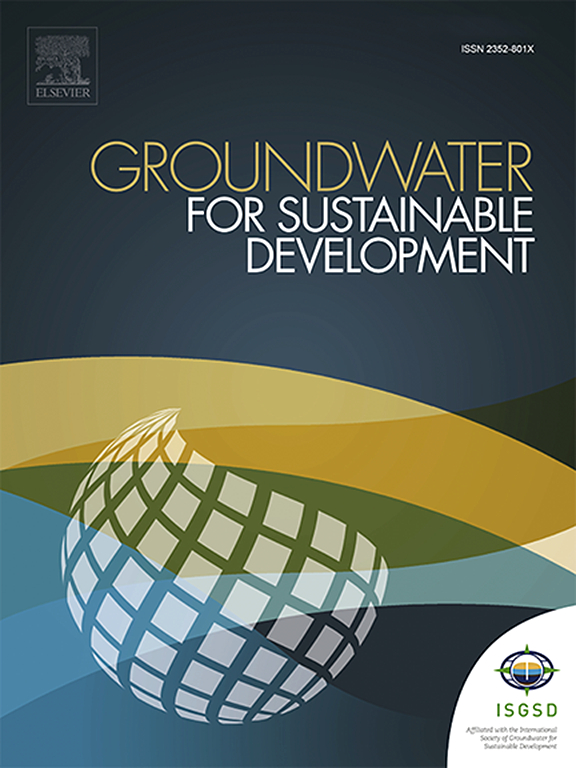Geoelectric layer susceptibility and vulnerability index mapping of Ifedore Local Government Area, Ondo State, Nigeria
IF 4.9
Q2 ENGINEERING, ENVIRONMENTAL
引用次数: 0
Abstract
Groundwater contamination remains a critical threat to water security, especially in areas where aquifers serve as the main source of potable water. In Ifedore Local Government Area, Ondo State, Nigeria, groundwater vulnerability has not been fully assessed, posing a risk to water resources. This study evaluates the region's vulnerability using two complementary models: the Groundwater Occurrence, Overlying Lithology, and Depth to Aquifer (GOD) model and the Geoelectric Layer Susceptibility Index (GLSI). The aim is to assess the protective capacity of aquifers and identify areas prone to contamination. Vertical Electrical Sounding (VES) data were utilized to derive geoelectrical parameters for the GLSI, while basic hydrogeological data supported the GOD model. Results from the GOD model indicate 60 % low, 3 % medium, and 37 % negligible vulnerability. The GLSI model, which integrates resistivity and vadose zone thickness, reveals 20 % low, 73 % medium, and 7 % high vulnerability. Both models indicate that vulnerability ranges from low to moderate, with some areas more susceptible to surface contaminants. Sensitivity analysis was conducted by introducing ±10 % variations to the parameters of both models. The findings show moderate sensitivity, with vulnerability classifications shifting in several VES locations, particularly in the GLSI model. This highlights the need for precise data acquisition—especially for parameters like resistivity and layer thickness—to ensure accurate assessments. Additionally, land use and land cover (LULC) analysis was integrated to evaluate anthropogenic influence on aquifer vulnerability. Areas with agricultural and urban land uses showed elevated risks, underlining the importance of managing land activities near aquifer recharge zones. The study concludes that combining GOD, GLSI, and LULC data enhances groundwater vulnerability assessments and supports the development of effective water protection and land-use strategies in data-scarce, crystalline terrains.

尼日利亚Ondo州Ifedore地方政府区地电层易损性和易损性指数绘制
地下水污染仍然是对水安全的严重威胁,特别是在以含水层为主要饮用水源的地区。在尼日利亚翁多州的伊费多尔地方政府区,地下水脆弱性尚未得到充分评估,对水资源构成风险。本研究利用地下水产状、上覆岩性和含水层深度(GOD)模型和地电层敏感性指数(GLSI)两种互补模型对该地区的脆弱性进行了评价。其目的是评估含水层的保护能力并确定容易受到污染的地区。利用垂直电测深(VES)数据推导GLSI的地电参数,而基础水文地质数据支持GOD模型。GOD模型的结果显示,60%的漏洞为低漏洞,3%为中等漏洞,37%为可忽略漏洞。综合电阻率和渗透带厚度的GLSI模型显示,20%的低易损性、73%的中易损性和7%的高易损性。两种模式都表明,脆弱性范围从低到中等,有些地区更容易受到地表污染物的影响。通过对两种模型的参数引入±10%的变化进行敏感性分析。研究结果显示出适度的敏感性,在几个VES位置,特别是在GLSI模型中,漏洞分类发生了变化。这突出了对精确数据采集的需求,特别是对电阻率和层厚等参数的采集,以确保准确的评估。此外,结合土地利用和土地覆盖(LULC)分析,评价了人类活动对含水层脆弱性的影响。农业和城市土地利用地区显示出较高的风险,强调了管理含水层补给带附近土地活动的重要性。该研究的结论是,结合GOD、GLSI和LULC数据可以增强地下水脆弱性评估,并支持在数据稀缺的结晶地形中制定有效的水资源保护和土地利用策略。
本文章由计算机程序翻译,如有差异,请以英文原文为准。
求助全文
约1分钟内获得全文
求助全文
来源期刊

Groundwater for Sustainable Development
Social Sciences-Geography, Planning and Development
CiteScore
11.50
自引率
10.20%
发文量
152
期刊介绍:
Groundwater for Sustainable Development is directed to different stakeholders and professionals, including government and non-governmental organizations, international funding agencies, universities, public water institutions, public health and other public/private sector professionals, and other relevant institutions. It is aimed at professionals, academics and students in the fields of disciplines such as: groundwater and its connection to surface hydrology and environment, soil sciences, engineering, ecology, microbiology, atmospheric sciences, analytical chemistry, hydro-engineering, water technology, environmental ethics, economics, public health, policy, as well as social sciences, legal disciplines, or any other area connected with water issues. The objectives of this journal are to facilitate: • The improvement of effective and sustainable management of water resources across the globe. • The improvement of human access to groundwater resources in adequate quantity and good quality. • The meeting of the increasing demand for drinking and irrigation water needed for food security to contribute to a social and economically sound human development. • The creation of a global inter- and multidisciplinary platform and forum to improve our understanding of groundwater resources and to advocate their effective and sustainable management and protection against contamination. • Interdisciplinary information exchange and to stimulate scientific research in the fields of groundwater related sciences and social and health sciences required to achieve the United Nations Millennium Development Goals for sustainable development.
 求助内容:
求助内容: 应助结果提醒方式:
应助结果提醒方式:


